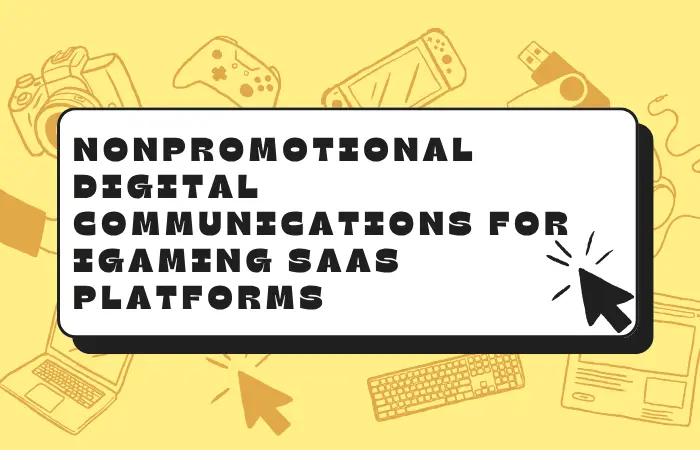Things are definitely shifting—non-promotional digital communications seem to be changing how people feel about using casino and slot SaaS platforms, though it’s… maybe not a total overhaul just yet. More and more, operators are putting money and time into messages that aim to teach, clarify, or just build a sense of trust. About 68% of leading platforms are mixing in tutorials, policy reminders, and notes on responsible gaming, along with their standard marketing.
Engagement numbers have ticked up, too; apparently, users stick around about 14% longer per visit when there’s genuinely useful content on offer. Of course, it’s not purely about users—this trend might just help companies appear more authoritative, and maybe even keep regulators happier as laws and expectations grow a bit more complicated. Is it all about sustainability now? That’s the sense in the air, at least for the platforms hoping to stick around.
Defining Nonpromotional Digital Messaging
When people talk about non-promotional digital messaging, generally what they mean is all the communication that’s aimed at informing, supporting, or educating users—not specifically nudging them to play or make a deposit. So, think: updates about a new security feature, changes to small print, notifications that point out recently added responsible gambling tools. For example, a newsletter might detail updates to withdrawal procedures or spotlight new educational articles rather than urging users toward online slots like gates of olympus.
Email, in-app pop-ups, even those digital screens in brick-and-mortar casinos—they all get used for this kind of outreach. Where rules are strict, separating promotional from non-promotional content is not just best practice but, obviously, essential—otherwise the penalties can be enough to make an operator think twice. There’s been, you might call it, a pivot among industry leaders: the old strategy of marketing isn’t cutting it on its own. Instead, the focus drifts toward building something users might actually stick with.
Channel Selection and Regulatory Demands
Not all digital communication channels land the same. Email newsletters? Still popular. Web articles and push notifications often rank highly too, especially when they’re used to share tips on staying secure or explanations for new features—like multifactor authentication. These updates—unlike promotional messages about games such as gates of Olympus—add value without urging players to wager. Within physical casino spaces, the digital signage is usually less about shouting offers and more about practicalities: maps, daily events, and reminders about self-exclusion options.
Then there’s social media—Twitter and Instagram feeds now prop up initiatives that are more about community and best practices. The content isn’t just for show; regulations like GDPR and CCPA mean everything has to be clearly labeled and consent has to be handled with care. Actually, quite a few Casino-as-a-Platform solutions are introducing automated workflows just for tracking, since any slip in compliance could—with today’s climate—be a headache no one wants. At this point, being transparent isn’t just friendly, it’s probably the most important thing for keeping user trust intact.
Technology and Personalization in Digital Engagement
There was a time when digital messaging was just a blast—you’d send the same thing to everyone, end of story. Now, though, SaaS platforms are leaning heavily on AI to split audiences up and send information that (in theory, at least) matches what people want. Some users indicate an interest in guides, others in system updates, so AI sorts all that out, and the content follows. Big data also gets involved—a first-timer might get onboarding guidance but someone who’s played for years gets updates about new responsible gaming tools instead.
Actually, it’s not only about messaging over email. The same logic is getting stitched into mobile apps, desktop notifications,and even kiosks at the casino entrance. CRM systems are working in the background, keeping tabs on who saw which message and whether they actually clicked. Platforms that aren’t investing in this kind of setup are probably going to struggle, especially as everyone grows more nervous about data privacy.
Strategic Value and Industry Pitfalls
The platforms that seem to treat nonpromotional communication as part of their main strategy—not just a compliance box to tick—are starting to see some results. Customer retention and net promoter scores both go up when platforms share something genuinely educational. That said, pitfalls haven’t gone anywhere. The quickest way to lose customer trust (or land in hot water with regulators) is to blend these informative updates with low-effort promo or stuff that feels like spam.
Data misuse, well, that’s always lurking in the background; it doesn’t take much—a leak or some careless handling—and a platform’s reputation can take a real hit (plus whatever fines might come with that). The standout operators? They’re investing more in content planning, slotting in compliance checks throughout their processes, and actually making support staff part of the effort to distinguish between messaging that informs and messaging that markets. It’s not an exact science, but the benchmarks are there for any platform willing to match them.
Responsible Digital Engagement in Gaming
A lot of leadership talk centers on responsible gambling, and, honestly, it seems to have become a baseline for how communication strategies are built. When platforms draw clear lines between promotional and nonpromotional messages, that’s usually interpreted as a real effort to put player health and transparency first—not just saying so for PR. Informational notes nudge people to remember their limits or where to turn for support.
Frequent reminders about self-exclusion, safer play, and privacy protections give players more tools, maybe helping them think twice before making impulsive decisions. There’s encouragement from regulators, too. And the academic side? Some research points out a mild boost in user trust for platforms that prioritize clear, honest engagement. Will the industry standardize around these approaches as laws tighten? There’s a decent chance, but as always, the details are still unfolding.







